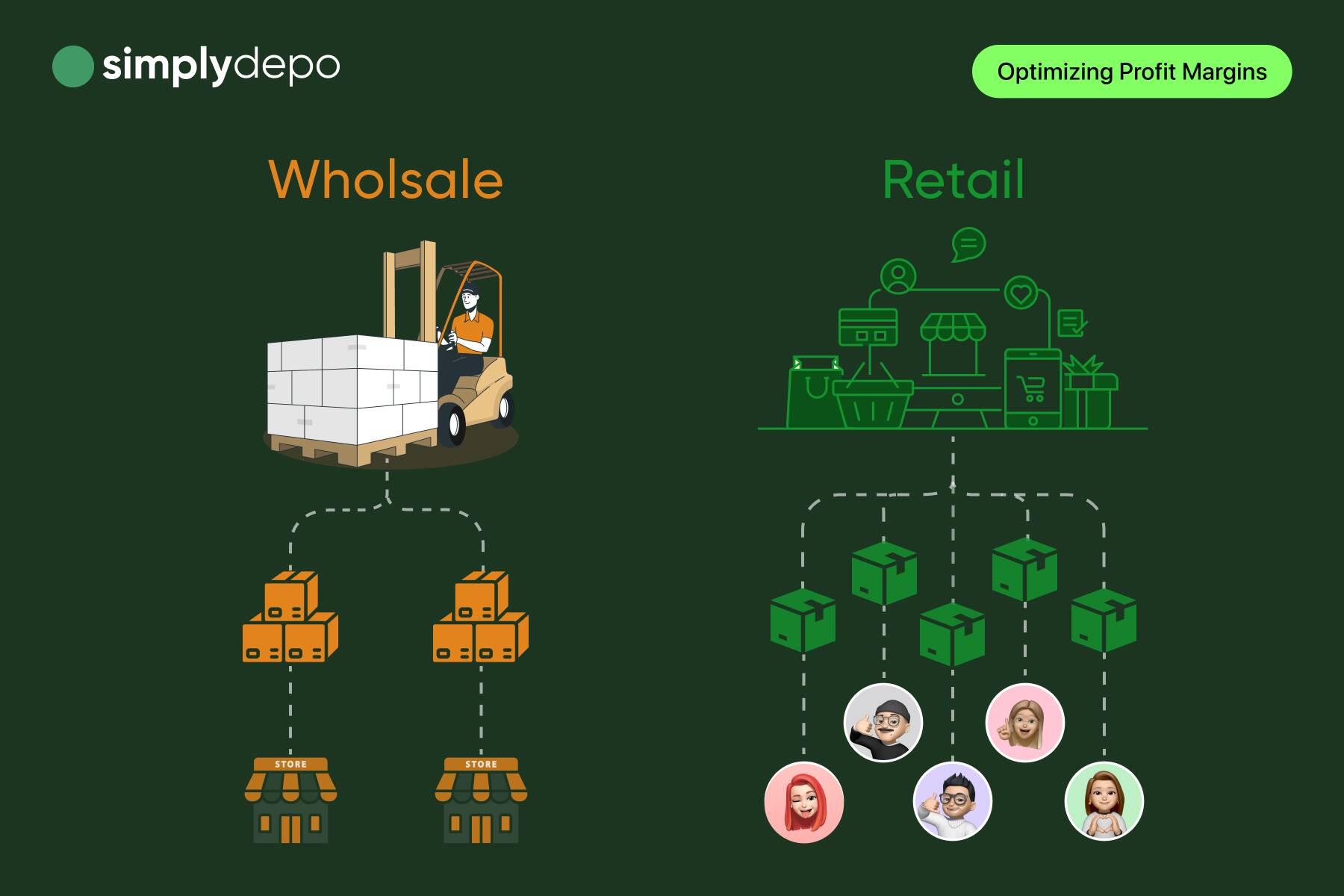B2B vs D2C: Which Distribution Model Gives you the Most Margins?

How businesses distribute their products affects their profitability. Two main models dominate: Business-to-Business (B2B) and Direct-to-Consumer (D2C). Choosing the right distribution strategy can impact revenue, operational efficiency and customer relationships. B2B offers stability and scalability while D2C gives higher profit margins and more control over your brand. We have compared both models to look at the impact on profit margins and see how SimplyDepo, a wholesale management platform, can help you optimize your distribution strategy.
How to Choose RightRetail Distribution Model
A retail distribution model is how products get from manufacturers to end consumers. It’s logistics, supply chain management, pricing strategies and marketing tactics. The choice between B2B and D2C depends on your business goals, target market and operational capabilities.
The Traditional B2B Model
B2B distribution is selling products in bulk to wholesalers, retailers or other businesses who then sell to consumers. This has been the backbone of commerce for decades, offering stability and predictability.
Key Characteristics of B2B:
- Bulk Orders: Sales are in large quantities, reducing per unit shipping and production costs.
- Long Term Contracts: Businesses partner with wholesalers and retailers for recurring revenue.
- Lower Customer Acquisition Costs (CAC): Companies target fewer buyers who place large, recurring orders.
- Longer Sales Cycles: Negotiations, approvals and contracts can take weeks or months.
- Stable Cash Flow: Wholesale deals often come with large, consistent orders reducing financial risk.
Examples of B2B Companies in Retail
- Faire – A wholesale marketplace connecting independent retailers with brands, simplifying the supply chain.
- Alibaba – A global B2B platform that enables businesses to source products directly from manufacturers and wholesalers.
- Flexe – Provides on-demand warehousing and logistics solutions for retailers and brands to scale distribution efficiently.
- NuORDER – A digital B2B e-commerce platform that helps brands and retailers streamline the wholesale buying process.
- SPS Commerce – A cloud-based supply chain management company offering EDI (electronic data interchange) solutions for retailers and suppliers.
The Rise of the D2C Model
D2C distribution allows brands to sell directly to consumers, bypassing intermediaries. This model has grown with the rise of e-commerce, social media marketing and subscription services.
Key Characteristics of D2C:
- Higher Profit Margins: No middlemen means more revenue for you.
- Brand Control: You manage pricing, marketing and customer interaction directly.
- Faster Market Feedback: Direct interaction helps you adjust products and strategy quickly.
- Higher Customer Acquisition Costs: Digital marketing, influencer partnerships and customer support requires a lot of investment.
- Logistics Challenges: Brands handle inventory, fulfillment and customer service in-house.
D2C Companies in Retail
- Warby Parker – A D2C eyewear brand known for its try-at-home model and direct online sales.
- Glossier – A beauty brand that built its business primarily through social media and a direct-to-consumer online approach.
- Allbirds – A sustainable footwear company selling directly to consumers via its website and owned retail stores.
- Casper – A mattress brand that disrupted the traditional industry with a direct-to-consumer e-commerce model.
- Everlane – A fashion brand that emphasizes transparency in pricing and production, selling directly to customers online.
B2B vs D2C: Impact on Profit Margins
B2B Profit Margins
B2B businesses have lower profit margins per unit but higher volume sales.
Key Profitability Factors:
- Bulk Discounts: Selling in volume reduces costs but also means lower per unit margins.
- Negotiated Pricing: Custom pricing agreements can mean tighter margins.
- Operational Efficiency: Streamlined supply chains and predictable demand optimises costs.
- Longer Sales Cycles: Delayed revenue due to contract negotiations and approvals.
According to a study by Forbes, B2B companies typically have a gross margin of 10-30%, depending on the industry and supply chain efficiencies.
D2C Profit Margins
D2C brands eliminate wholesalers and retailers and get higher profit margins but more operational complexity.
Key Profitability Factors:
- Direct Pricing Control: You can set higher price points.
- Customer Acquisition Costs: Digital ads and influencer marketing are expensive.
- E-commerce and Fulfillment Costs: Shipping, returns and customer service increase expenses.
- Brand Loyalty: Personalised experiences lead to repeat purchases.
According to McKinsey, D2C companies often achieve gross margins of 40-60%, compared to traditional retail.
Industry Insights: US Market Trends
Growth of D2C Brands
- D2C e-commerce sales in the U.S. reached $151.2 billion in 2022, with a projected CAGR of 15% through 2025.
- 60% of manufacturers are investing in D2C strategies to build direct relationships with customers.
- Leading brands like Nike, Warby Parker, and Dollar Shave Club have shifted to D2C to increase margins and brand control.
B2B Resilience in Wholesale and Retail
- The B2B e-commerce market is valued at $7.7 trillion, significantly larger than B2C.
- 80% of B2B buyers now expect digital self-service options, similar to D2C experiences.
- B2B marketplaces like Amazon Business and Alibaba have grown rapidly, improving digital wholesale efficiency.
How SimplyDepo Optimizes Both Models
What is SimplyDepo?
SimplyDepo is a digital wholesale platform that simplifies order management, inventory tracking,B2B & D2C operations. It helps manufacturers, wholesalers and distributors to streamline their sales process.
Benefits for B2B and D2C Businesses
B2B Businesses:
- Automated Order Processing: Less manual work and errors.
- Real-time Inventory Management: No stockouts and over-ordering.
- CRM Integration: Better relationships with retail buyers.
D2C Brands:
- E-commerce Order Sync: Unified sales channels for better inventory control.
- Customer Analytics: Insights for targeted marketing.
- Supply Chain Optimisation: Faster and cheaper fulfillment.
SimplyDepo already helped : HC Foods to imprease profit margin and optimize operations
Problem: HC Foods, a growing food distributor, had manual order tracking, frequent order errors and delayed shipments which resulted in revenue loss and customer dissatisfaction.
Solution: Implemented SimplyDepo’s AI-powered distribution system to digitize and automate their supply chain process.
Results:
- 30% Faster Order Fulfillment: Automated order intake and fulfillment tracking.
- 20% Inventory Waste Reduction: Real-time inventory updates prevented overstocking and stockouts.
- 15% Profit Margin Increase: Cost savings from operational efficiency.
- Multi-Channel Integration: Integrated SimplyDepo with their B2B online portal and retail partners for a seamless supply chain.
- Data-Driven Forecasting: AI-powered analytics for demand patterns to optimise purchasing and minimize waste.
Conclusion: Which Model is Right for You?
| Factor | B2B | D2C |
|---|---|---|
| Profit Margins | Lower per unit, higher volume | Higher per unit, lower volume |
| Customer Acquisition Costs | Low | High |
| Operational Complexity | Moderate | High (logistics, fulfillment, customer service) |
| Brand Control | Limited | High |
| Revenue Stability | Predictable contracts | Market-dependent |
Both B2B and D2C models have unique advantages. While B2B offers stability and scale, D2C provides higher margins and brand control. The best approach depends on business goals, industry trends, and operational capacity.
Leveraging technology like SimplyDepo helps businesses optimize margins, streamline logistics, and scale efficiently, whether in B2B or D2C distribution.
Explore how SimplyDepo can transform your distribution strategy – Book a demo now
